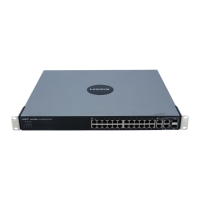3-5
Cisco Wireless LAN Controller Configuration Guide
OL-9141-03
Chapter 3 Configuring Ports and Interfaces
Overview of Ports and Interfaces
Note GLC-T adapters can purchased for use with wire Ethernet cables. This adapter converts the controller
port into a gigabit Ethernet port with an RJ45 connector for wire Ethernet cables. The wire Ethernet
cable from the controller must be connected to a gigabit Ethernet port on the switch. Fiber adapters might
also be required for the switch if it has fiber ports.
Note For smaller systems needing only 6 access points, the Cisco 2006 or 2106 controllers can be used. A
Cisco CAT6k with a service module or a Cisco 2800 router can also support 6 access points.
Service Port
Cisco 4400 series controllers also have a 10/100 copper Ethernet service port. The service port is
controlled by the service-port interface and is reserved for out-of-band management of the controller and
system recovery and maintenance in the event of a network failure. It is also the only port that is active
when the controller is in boot mode. The service port is not capable of carrying 802.1Q tags, so it must
be connected to an access port on the neighbor switch. Use of the service port is optional.
Note The Cisco WiSM’s 4404 controllers use the service port for internal protocol communication between
the controllers and the Supervisor 720.
Note The Cisco 2000 series controller and the controller in the Cisco Integrated Services Router do not have
a service port.
Note The service port is not auto-sensing. You must use the correct straight-through or crossover Ethernet
cable to communicate with the service port.
Interfaces
An interface is a logical entity on the controller. An interface has multiple parameters associated with it,
including an IP address, default-gateway (for the IP subnet), primary physical port, secondary physical
port, VLAN identifier, and DHCP server.
These five types of interfaces are available on the controller. Four of these are static and are configured
at setup time:
• Management interface (Static and configured at setup time; mandatory)
• AP-manager interface (When using Layer 3 LWAPP, static and configured at setup time; mandatory)
• Virtual interface (Static and configured at setup time; mandatory)
• Service-port interface (Static and configured at setup time; optional)
• Dynamic interface (User-defined)

